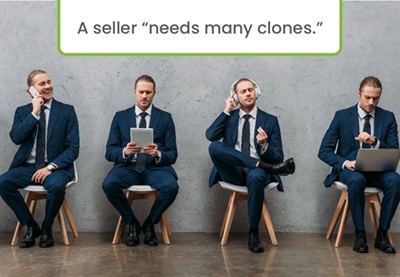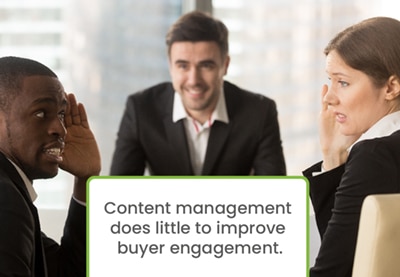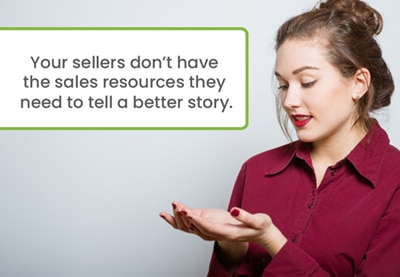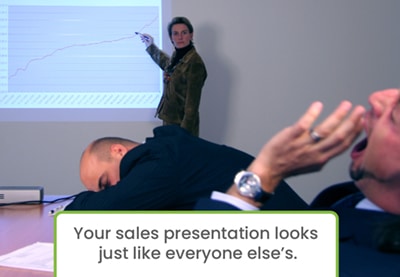
An estimated 66% of a seller’s day is focused on writing and designing presentations and marketing materials, managing accounts, performing customer service, and a whole lot more.
Sales reps are hired to sell, but there’s rarely time for that. Allowing impactful selling to happen means eliminating the burden of searching for content, customizing it for each prospect, building presentations from clunky, static templates, and recording all of the details of the interaction. This is the reason why so many more companies today prioritize sales enablement. Yet, more than two-thirds of companies who invest in a sales enablement solution are not seeing the results they expected (CSO Insights). Who (or what) is to blame?
Why does Sales Enablement Fail?
Aside from constantly being sidelined from selling, your reps also lack the flexible, quality content and insights they need to connect with buyers in a memorable way. While implementing a sales enablement technology to solve for sales efficiency challenges discussed above is a necessary first step, it won’t take your sellers over the finish line. Implementing a solution that also increases the effectiveness of your sellers by empowering them to lead more personalized, engaging and prescriptive sales interactions backed by real data and insights is paramount to the success of your deployment and your business. Here’s why:

You’re putting your content in one place to create a single source of truth for sellers. Your content is accurate, up-to-date, and consistent, but does it resonate with buyers? Available content doesn’t mean interactive, data-driven content that moves buyers. If it feels generic, it feels impersonal to the buyer and you only have one chance to make a first impression.
While sales enablement can improve sales productivity by putting all of your content in one place and making it accessible online or off, it can also make your sellers more effective in every sales interaction. How? Using your sales enablement technology in conjunction with your CRM to automatically record meeting details and track how content is being leveraged by sales and consumed by prospective buyers allows you to tie content back to revenue. Marketers can begin to strategize based on what truly works and what doesn’t, rather than taking a stab in the dark, and buyers receive more relevant and engaging content as a result. Sales managers can use the data to create individual sales training and coaching resources, ensuring every salesperson is sales-ready and able to pivot in the moment to take the conversation wherever the buyer wants to go.
We dive deeper into this in our blog titled “What Your Sales Enablement Solution is Missing.” You can read it here.

Loading a bunch of product brochures, slides about your company, and sell sheets into a sales application will inevitably make your sellers more knowledgeable about your solution. But will it motivate your buyers to purchase? Static content worked yesterday, and it didn’t last long. Content should be personalized to tell the story from each unique buyer’s perspective. It should allow sellers to dynamically assess buyer challenges and prescribe a solution that solves for them.
Your buyer will take interest in your product features, company success, etc. at some point in the buyer journey, but to get to that point, they first need to know that you understand their pain points and can add value to their business with your solution. How do you ensure your sales reps can tell a story about your solution in the context of what the buyer cares about? Sales enablement technology that leverages interactive value-selling tools like TCO comparisons and ROI calculators to capture input from the buyer and quantify the business value of your solution in real-time go a long way in building confidence and credibility in your offering and accelerating purchase decisions.
It worked for leading tech company Splunk, it can work for you.

Salespeople get a bad rap. The second they walk into a “pitch” and throw their PowerPoint presentation up on the screen, they’re already at a disadvantage. But using sales enablement technology to differentiate your sellers, brand, and solutions can give you a leg up on the competition. How? Design your sales application to create interactive and compelling sales experiences. Mix and match various content formats, pull real-time data into conversations, and leave your traditional PowerPoint presentations behind.
Don’t select a sales enablement vendor who can get you to the status quo, select a partner – someone who can help you truly customize your sales application in line with your buyers’ expectations and your brand. Your business is unique, and you understand your buyer’s journey better than anyone else. Your sales application can and should create a sales experience that reflects that.
Sidenote: It’s easier (and less expensive) than you think to get there.
This year, 56% of sales reps won’t meet their quotas (Salesforce). Will yours? Sales enablement is only as successful as you make it. Don’t stop at improving sales efficiency. To maximize the return on investment of your sales enablement solution, you must prioritize empowering your sellers to sell smarter, better, faster.
Don’t let your sales enablement solution fall flat. Contact our Advisory Services team today to learn how we partner with companies including PepsiCo, ThermoFisher Scientific, and Charles Schwab to create smart sales applications that enable you to quantify your unique value to buyers and tie sales content back to revenue.

Comments are closed.